Belkin F5D7230D Wireless G Router User Manual 07 365 DX WGRTR combined
Belkin International, Inc. Wireless G Router 07 365 DX WGRTR combined
Belkin >
Contents
user manual product 2 part 2
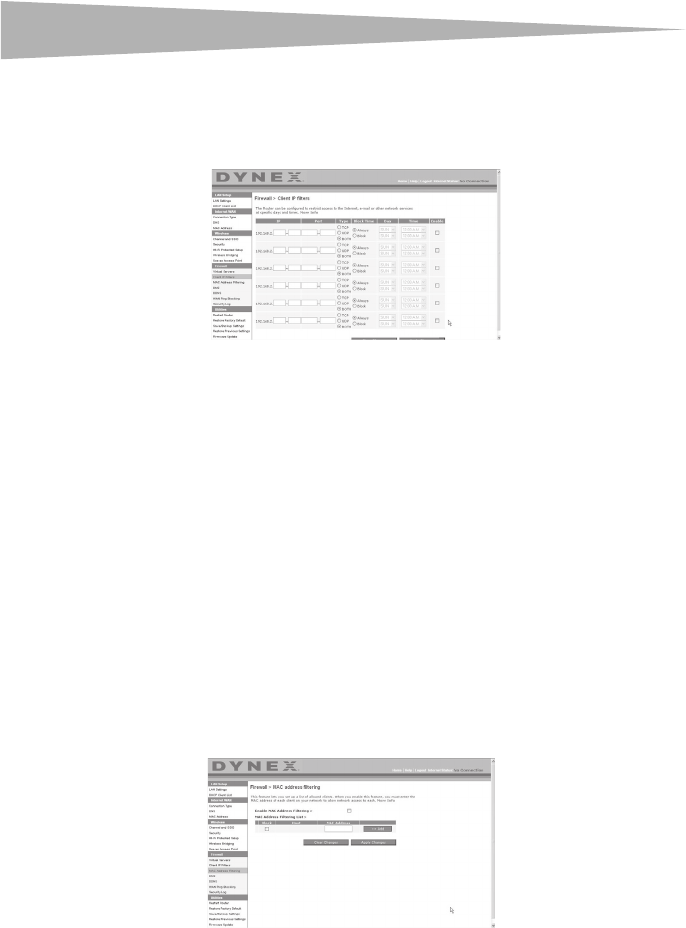
34 Setting up your wireless route
r
Setting Client IP Filters
The router can be configured to restrict access to the Internet, e-mail, or other network
services at specific days and times. Restriction can be set for a single computer, a range of
computers, or multiple computers.
To restrict Internet access to a single computer:
1Open the Firewall > Client IP filters page, then enter the IP address of the computer you
wish to restrict access to in the IP fields.
2Enter 80 in both the port fields, select Both, then select Block. You can also select
Always to block access all of the time.
3Select the day to start on top, the time to start on top, the day to end on the bottom,
and the time to stop on the bottom.
4Select Enable, then click Apply Changes. The computer at the IP address you
specified will now be blocked from Internet access at the times you specified. Be sure
you have selected the correct time zone under Utilities> System Settings> Time
Zone.
Setting MAC Address Filtering
The MAC address filter is a powerful security feature that allows you to specify which
computers are allowed on the network. Any computer attempting to access the network that
is not specified in the filter list will be denied access. When you enable this feature, you must
enter the MAC address of each client (computer) on your network to allow network access to
each.
To set MAC Address Filtering:
1Open the Firewall > MAC Address filters page, then click Enable MAC Address
Filtering.
2Enter the MAC address of each computer on your network by clicking in the space
provided and entering the MAC address of the computer you want to add to the list.
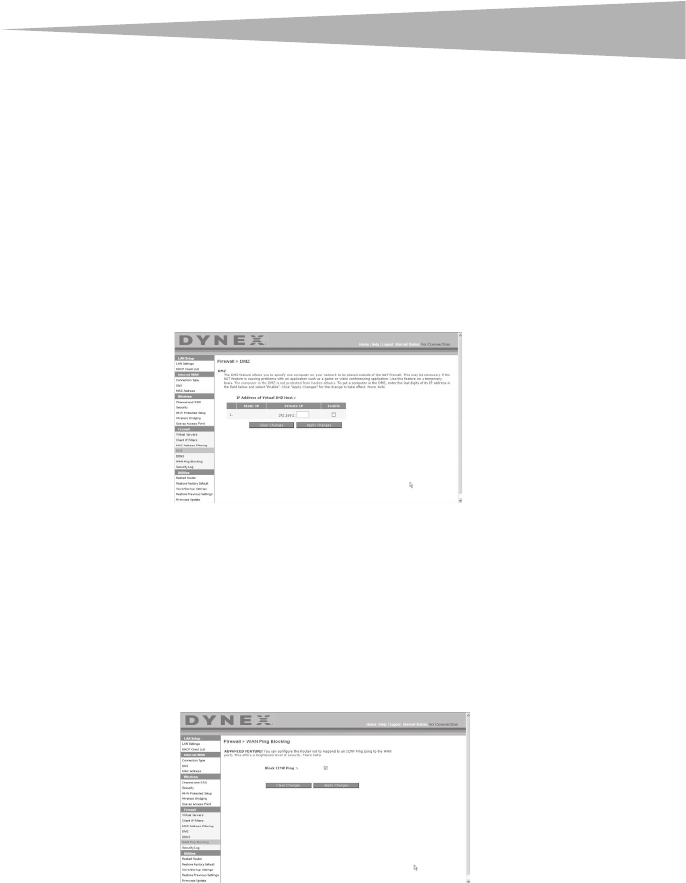
Setting up your wireless route
r
35
3Click Add, then click Apply Changes to save the settings. You can have a
MAC-address-filtering list of up to 32 computers.
Note: You will not be able to delete the MAC address of the computer you are using to access
the Router's administrative functions (the computer you are using now).
Enabling the Demilitarized Zone (DMZ)
The DMZ feature lets you specify one computer on your network to be placed outside of the
firewall. This may be necessary if the firewall is causing problems with an application such as
a game or video conferencing application. Use this feature on a temporary basis. The
computer in the DMZ is NOT protected from hacker attacks. If your ISP subscription provides
you with additional public (WAN) IP addresses, additional computers can be placed outside
the firewall provided each computer uses a different public (WAN) IP.
To set up a DMZ for a computer:
•Open the Firewall > DMZ page and enter the last digits of the computer’s IP address in
the IP field, click Enable, then click Apply Changes for the change to take effect.
WAN Ping Blocking
Computer hackers use what is known as pinging to find potential victims on the Internet. By
pinging a specific IP address and receiving a response from the IP address, a hacker can
determine that something of interest might be there. The router can be set up so it will not
respond to an ICMP ping from the outside. This heightens the level of security of your router.
To turn off the ping response
•Open the Firewall > WAN Ping Blocking page and select Block ICMP Ping, then click
Apply Changes. The router will not respond to an ICMP ping.
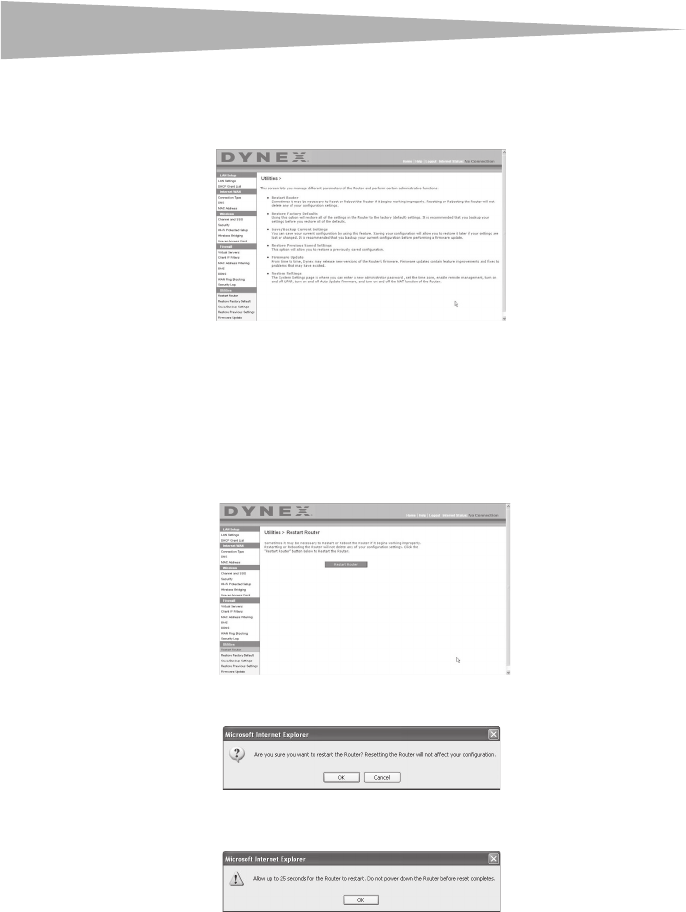
36 Setting up your wireless route
r
Utilities tab
This screen lets you manage different parameters of the router and perform certain
administrative functions.
Restarting the router
Sometimes it may be necessary to restart or reboot the router if it begins working
improperly. Restarting or rebooting the router will NOT delete any of your configuration
settings.
To restart the router to restore normal operation:
1Under the Utilities heading on the left menu, click Restart Router. The Restart
Router page opens.
2Click the Restart Router button. The following message appears.
3Click OK. The following message appears.
4Click OK. Restarting the router can take up to 25 seconds. It is important not to turn off
the power to the router during the restart.
A 25-second countdown will appear on the screen. When the countdown reaches zero,
the router will be restarted. The router's home page should appear automatically. If
not, type in the router's address (default = 192.168.2.1) into the navigation bar of
your browser.
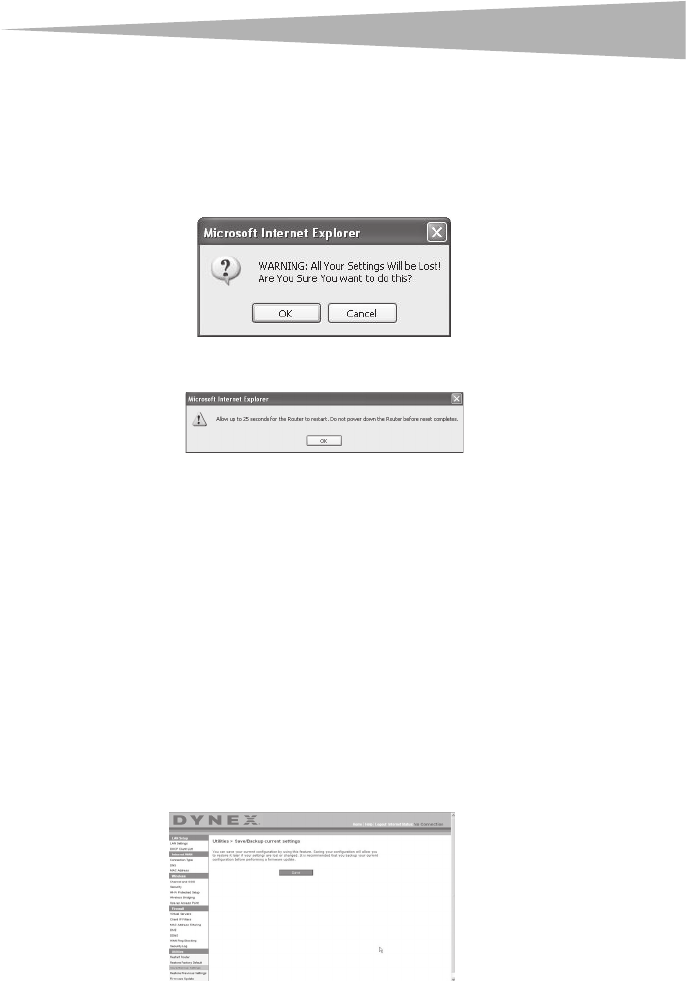
Setting up your wireless route
r
37
Restoring factory default settings
Using this option will restore all of the settings in the router to the factory (default) settings.
It is recommended that you back up your settings before you restore all of the defaults.
To restore factory default settings:
1Under the Utilities heading on the left menu, click Restore Defaults. The following
warning will appear.
2Click OK. The following message appears.
3Click OK. Restoring the defaults includes restarting the router. Restarting the router
can take up to 25 seconds. It is important not to turn off the power to the router during
the restart.
A 25-second countdown will appear on the screen. When the countdown reaches zero,
the router will be restarted. The router's home page should appear automatically. If
not, type in the router's address (default = 192.168.2.1) into the navigation bar of
your browser.
Saving a current configuration
You can save your current configuration by using this feature. Saving your configuration will
allow you to restore it later if your settings are lost or changed. It is recommended that you
back up your current configuration before performing a firmware update.
To save a current configuration:
1Under the Utilities heading on the left menu, click Save/Backup Settings. The
Save/Backup Settings page opens.
2Click Save. The File Download window opens.
3Click Save. A window will open that lets you select the location where you want to
save the configuration file.
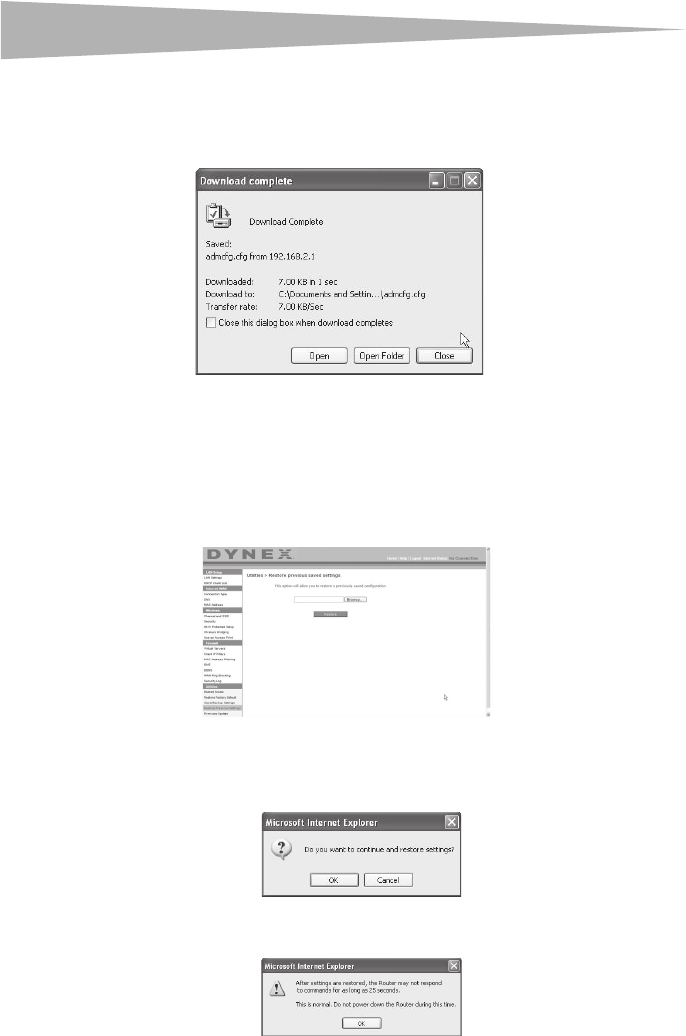
38 Setting up your wireless route
r
4Select a location. You can name the file anything you want, or use the default name
“Config.” Be sure to name the file so you can locate it yourself later. When you have
selected the location and name of the file, click Save.
5When the save is complete, you will see the following window.
6Click Close. The configuration is now saved.
Restoring a previous configuration
This option will let you restore a previously saved configuration.
To restore a previously saved configuration:
1Under the Utilities heading on the left menu, click Restore Previous Settings. The
Restore Previous Settings page opens.
2Click Browse. A window opens that lets you select the location of the configuration
file. All configuration files end with a “.bin”. Locate the configuration file you want to
restore, then double-click on it. The following message opens.
3Click OK. A reminder window appears.
It will take up to 35 seconds for the configuration restoration to complete.
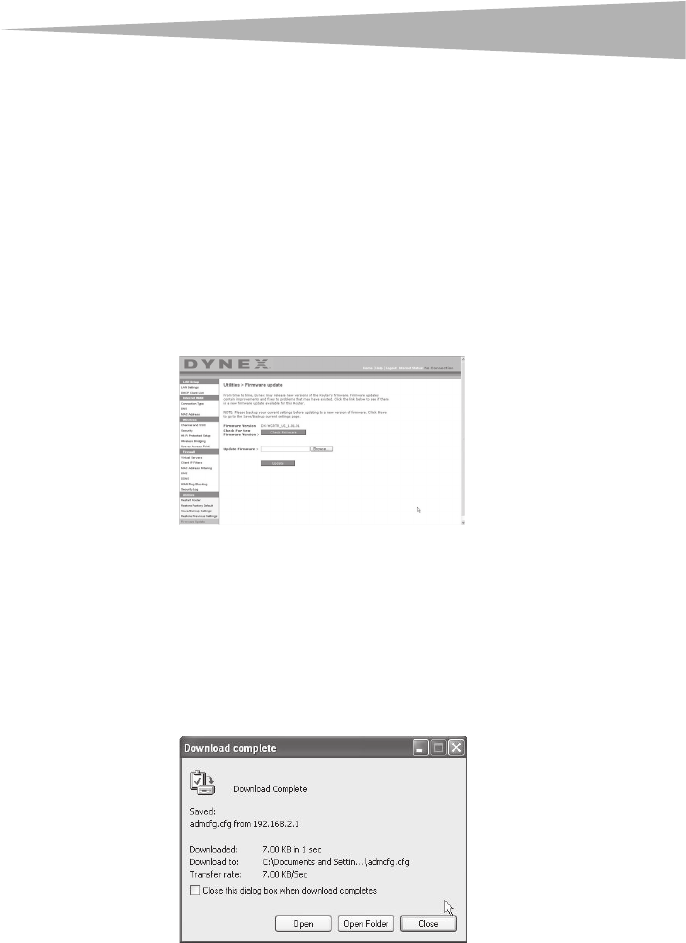
Setting up your wireless route
r
39
4Click OK. A 35-second countdown will appear on the screen. When the countdown
reaches zero, the router's configuration will be restored. The router's home page
should appear automatically. If not, type in the Router's address (default =
192.168.2.1) into the navigation bar of your browser.
Updating the firmware
From time to time, Dynex may release new versions of the router's firmware. Firmware
updates contain feature improvements and fixes to problems that may exist. When Dynex
releases new firmware, you can download the firmware from the Dynex update Web site and
update your router's firmware to the latest version.
To search for and download a new version of the firmware:
1Under the Utilities heading on the left menu, click Firmware Update. The Utilities >
Firmware updates page opens.
2Click Check Firmware. The utility checks to see if there is an updated version of the
firmware available.
3If a new version of the firmware is available, a window will open that lets you select
the location where you want to save the firmware file. Select a location. You can name
the file anything you want, or use the default name. Be sure to save the file in a place
where you can locate it yourself later. When you have selected the location, click Save.
Note: We suggest saving this to your desktop to make it easy to locate the file.
4When the save is complete, you will see the following window.
5Click Close. The download is complete. To update the firmware, follow the steps in To
updating the router's firmware.
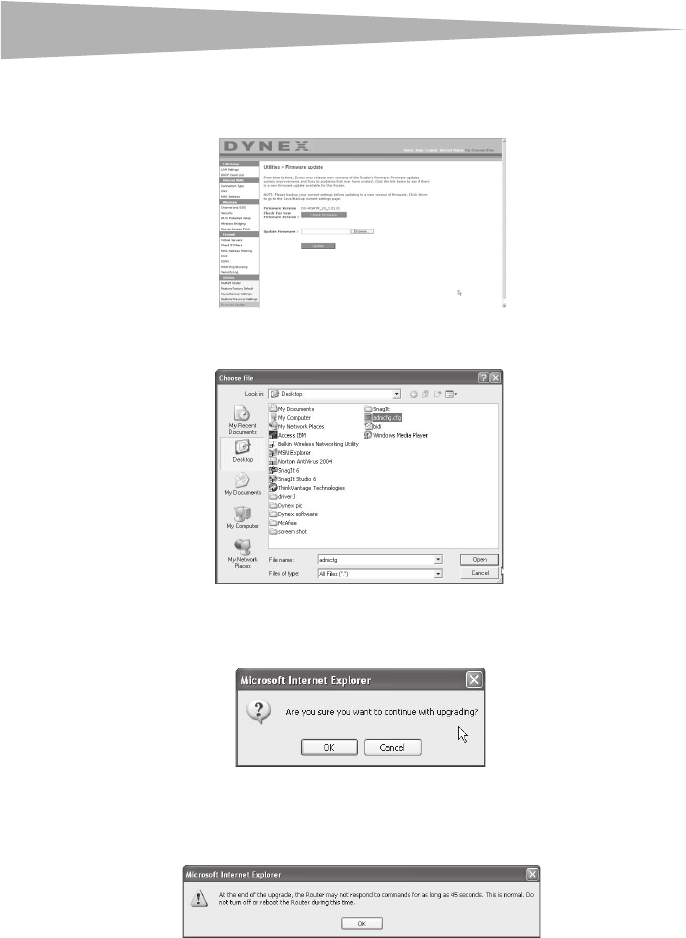
40 Setting up your wireless route
r
To update the router's firmware:
1On the Firmware Update page, click Browse. A window will open that lets you select
the location of the firmware update file.
2Browse to the firmware file you downloaded, then select the file by double-clicking on
the file name.
3The Update Firmware box will now display the location and name of the firmware
file you just selected. Click Update. You will be asked if you are sure you want to
continue.
4Click OK. You will see one more message. This message tells you that the router may
not respond for as long as one minute as the firmware is loaded into the router and the
router is rebooted.
5Click OK. A 60-second countdown will appear on the screen. When the countdown
reaches zero, the router's firmware update will be complete. The router's home page
should appear automatically. If not, type in the Router's address (default =
192.168.2.1) into the navigation bar of your browser.
The firmware update is complete.
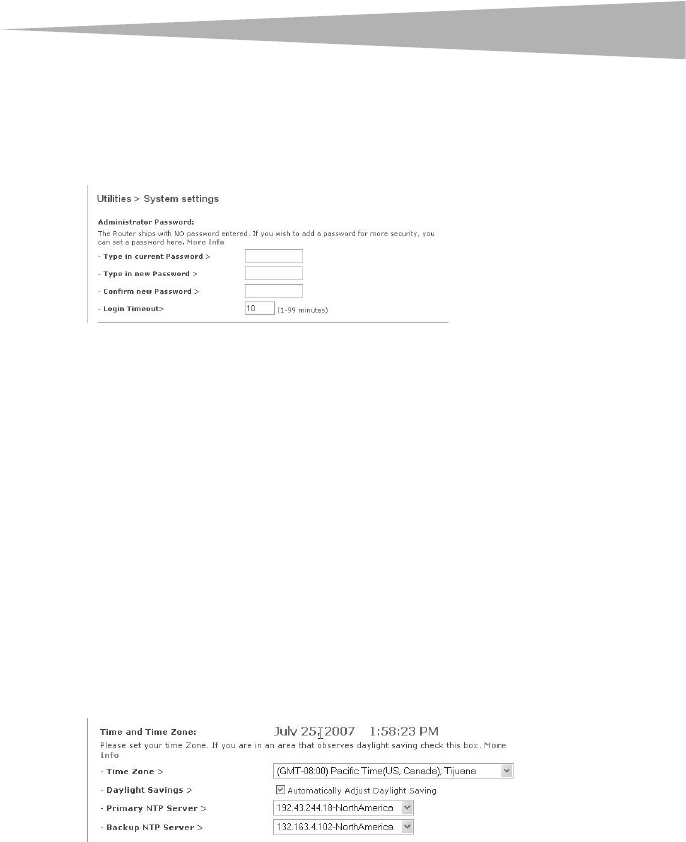
Setting up your wireless route
r
41
Changing system settings
The System Settings page is where you can enter a new administrator password, set the time
zone, enable remote management, and turn on and off the NAT function of the Router.
Setting or changing the Administrator Password
The router ships with NO password entered. If you wish to add a password for greater
security, you can set a password here. Write down your password and keep it in a safe place,
as you will need it if you need to log into the router in the future. It is also recommended that
you set a password if you plan to use the remote management feature of your router.
Changing the Login Time-Out Setting
The login time-out option allows you to set the period of time that you can be logged into
the router's Web-Based Advanced User Interface. The timer starts when there has been no
activity. For example, you have made some changes in the Web-Based Advanced User
Interface, then left your computer alone without clicking “Logout.” Assuming the time-out is
set to 10 minutes, then 10 minutes after you leave, the login session will expire. You will have
to log into the Router again to make any more changes. The login time-out option is for
security purposes and the default is set to 10 minutes.
Note: Only one computer can be logged into the router's Web-Based Advanced User Interface
at one time.
Setting the time and time zone
The router keeps time by connecting to a Simple Network Time Protocol (SNTP) server. This
allows the router to synchronize the system clock to the global Internet. The synchronized
clock in the router is used to record the security log and control client filtering. Select the
time zone that you reside in. If you reside in an area that observes daylight saving, then place
a check mark in the box next to Automatically Adjust Daylight Saving. The system clock
may not update immediately. Allow at least 15 minutes for the router to contact the time
servers on the Internet and get a response. You cannot set the clock yourself.
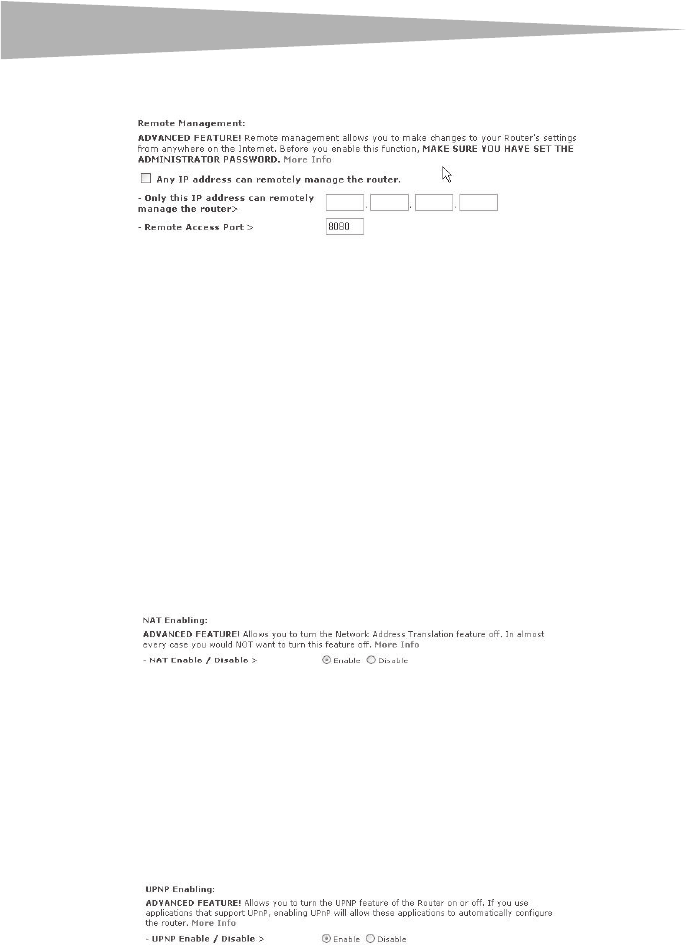
42 Setting up your wireless route
r
Enabling Remote Management
Before you enable this advanced feature of your router, MAKE SURE YOU HAVE SET THE
ADMINISTRATOR PASSWORD. Remote management allows you to make changes to your
router's settings from anywhere on the Internet. There are two methods of remotely
managing the router. The first is to allow access to the router from anywhere on the Internet
by selecting Any IP address can remotely manage the Router. By typing in your WAN IP
address from any computer on the Internet, you will be presented with a login screen where
you need to type in the password of your router. The second method is to allow a specific IP
address only to remotely manage the router. This is more secure, but less convenient. To use
this method, enter the IP address you know you will be accessing the router from in the space
provided and select Only this IP address can remotely manage the Router. Before you
enable this function, it is STRONGLY RECOMMENDED that you set your administrator
password. Leaving the password empty will potentially open your router to intrusion.
Enabling/Disabling Network Address Translation (NAT)
Note: This feature should only be modified by advanced users.
NAT is the method by which the router shares the single IP address assigned by your ISP with
the other computers on your network and is enabled by default. NAT should only be disabled
if your ISP assigns you multiple IP addresses or you need NAT disabled for an advanced
system configuration. If you have a single IP address and you turn NAT off, the computers on
your network will not be able to access the Internet. Other problems may also occur. Turning
off NAT will disable your firewall functions.
Enabling/Disabling UPnP
UPnP (Universal Plug-and-Play) is yet another advanced feature offered by your router. It is a
technology that offers seamless operation of voice messaging, video messaging, games, and
other applications that are UPnP-compliant. Some applications require the router's firewall
to be configured in a specific way to operate properly. This usually requires opening TCP and
UDP ports. An application that is UPnP-compliant has the ability to communicate with the
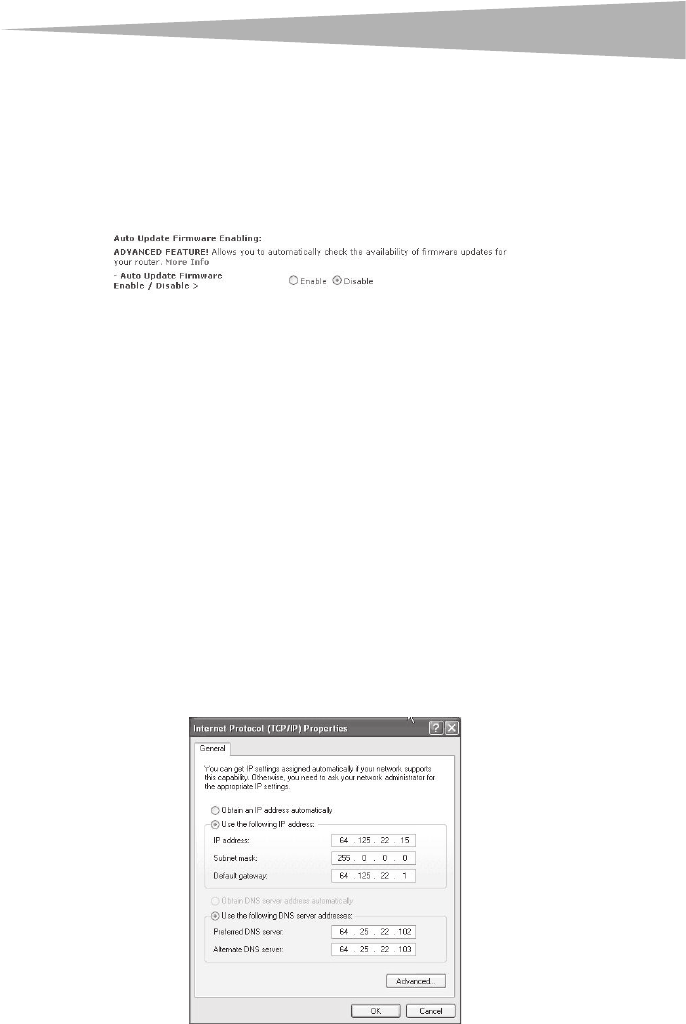
Setting up your wireless route
r
43
router, basically “telling” the router which way it needs the firewall configured. The router
ships with the UPnP feature disabled. If you are using any applications that are
UPnP-compliant, and wish to take advantage of the UPnP features, you can enable the UPnP
feature. Select Enable in the UPnP Enabling section of the Utilities page, then click Apply
Changes to save the change.
Enabling/Disabling Auto Firmware Update
This innovation provides the router with the built-in capability to automatically check for a
new version of firmware and alert you that the new firmware is available. When you log into
the router's Web-Based Advanced User Interface, the router will perform a check to see if
new firmware is available. If so, you will be notified. You can choose to download the new
version or ignore it. The router ships with this feature enabled. If you want to disable it, select
Disable, then click Apply Changes.
Manually configuring network settings
In order for your computer to properly communicate with your router, you will need to
change your PC's TCP/IP settings to DHCP.
To manually configure network adapters in Windows 2000, NT, XP, or Vista:
1Click Start, Settings, Control Panel.
2Double-click the Network and dial-up connections icon (Windows 2000) or the
Network icon (Windows XP or Vista).
3Right-click the Local Area Connection associated with your network adapter, then
select Properties from the list.
4Click Internet Protocol (TCP/IP), then click Properties. The following screen opens.

44 Setting up your wireless route
r
5If Use the following IP address is selected, your router will need to be set up for a
static IP connection type. Write the address information down. You will need to enter
this information into the router.
6If not already selected, select Obtain an IP address automatically and Obtain
DNS server address automatically, then click OK.
Your network adapter(s) are now configured for use with the router.
To manually configure network adapters in Windows 98SE or Me:
1Right-click My Network Neighborhood, then select Properties from the list.
2Select TCP/IP, then settings for your installed network adapter. You will see the
following window.
3If Specify an IP address is selected, your router will need to be set up for a static IP
connection type. Write down the address information. You will need to enter this
information into the router.
• Write in the IP address and subnet mask from the IP Address tab.
•Click the Gateway tab. Write the gateway address down in the chart.
•Click the DNS Configuration tab. Write the DNS address(es) in the chart.
4If not already selected, click Obtain IP address automatically in the IP Address
tab, then click OK.
5Restart the computer. When the computer restarts, your network adapter(s) are now
configured for use with the router.
Set up the computer that is connected to the cable or DSL modem FIRST using these steps.
You can also use these steps to add computers to your Router after the Router has been set up
to connect to the Internet.
To manually configure network adapters in Mac OS X:
1Click the System Preferences icon. The System Preferences menu opens.
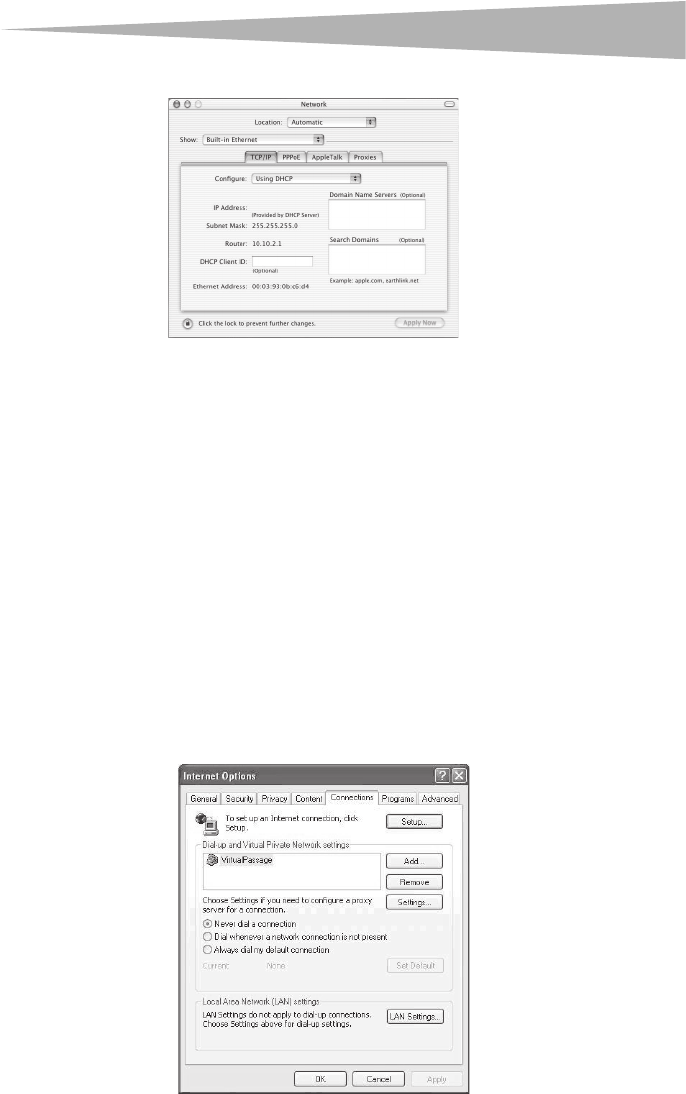
Setting up your wireless route
r
45
2Click Network. The Network window opens.
3Select Built-in Ethernet from the Show list.
4Click the TCP/IP tab. Next to Configure:, you should see Manually or Using DHCP. If
you do not, check the PPPoE tab to make sure that Connect using PPPoE is NOT
selected. If it is, you will need to configure your router for a PPPoE connection type
using your user name and password.
Note: If Manually is selected in the Configure list, your router will need to be set up for a
static IP connection type. Write down the address information. You will need to enter this
information into the router.
5Select Using DHCP from the Configure: list, then click Apply Now.
Your network adapter(s) are now configured for use with the router.
Recommended Web browser settings
In most cases, you will not need to make any changes to your Web browser's settings. If you
are having trouble accessing the Internet or the Web-Based Advanced User Interface, then
change your browser's settings to the recommended settings in this section.
To change settings in Internet Explorer 4.0 or higher:
1Start your Web browser. Open the Tools menu, then select Internet Options. The
Internet Options page opens.
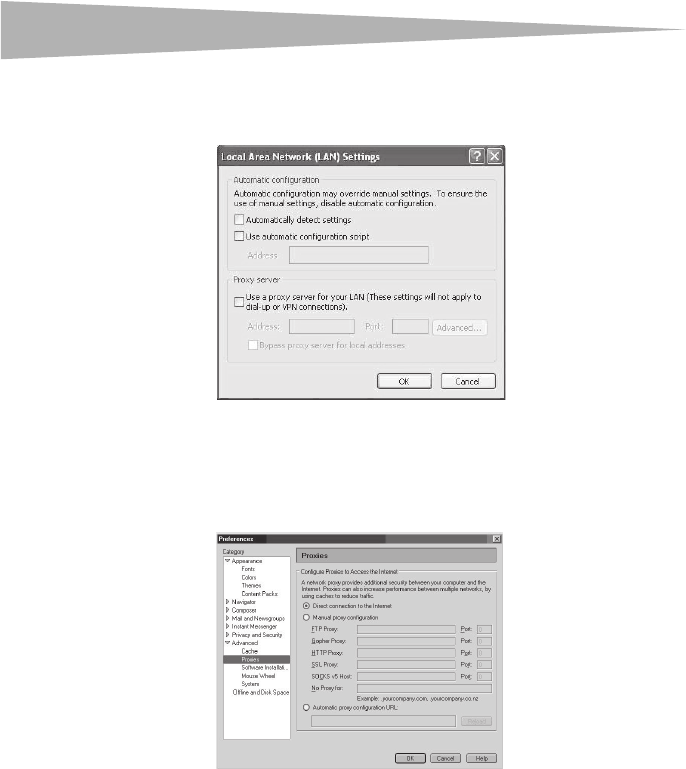
46 Troubleshooting
2Click the Connections tab, then select Never dial a connection. If you cannot make
a selection, go to the next step.
3Click LAN Settings…. The LAN Settings page opens.
4Make sure there are no check marks next to any of the displayed options. Click OK to
close the page, then click OK again in the Internet Options page to exit.
To change settings in Netscape® Navigator® 4.0 or higher:
1Start Netscape, then open the Edit menu and click Preferences. The Preferences page
opens.
2Click Advanced, then click Proxies.
3Select Direct connection to the Internet, then click OK to exit.
Troubleshooting
Placement of your router for optimal performance
Your wireless connection will be stronger the closer your computer is to your wireless router.
Typical indoor operating range for your wireless devices is between 100 and 200 feet. In the
same way, your wireless connection and performance will degrade somewhat as the
distance between your wireless router and connected devices increases. This may or may not
be noticeable to you. As you move farther from your wireless router, connection speed may
decrease.

Troubleshooting 47
Factors that can weaken signals simply by getting in the way of your network’s radio waves
are metal appliances or obstructions, and walls.
If you have concerns about your network’s performance that might be related to range or
obstruction factors, try moving the computer to a position between five and 10 feet from the
wireless router in order to see if distance is the problem.
Note: While some of the items listed below can affect network performance, they will not
prohibit your wireless network from functioning. If you are concerned that your network
is not operating at its maximum effectiveness, this checklist may help.
1. Placement of your wireless router
Place your wireless router, the central connection point of your network, as close as possible
to the center of your wireless network devices.
To achieve the best wireless network coverage for your “wireless clients,” (for example,
computers enabled by Wireless Notebook Cards, Wireless Desktop Cards, and Wireless USB
Adapters):
• Make sure that your wireless router’s antennas are parallel to each other, and are
positioned vertically (toward the ceiling). If your wireless router itself is positioned
vertically, point the antennas as much as possible in an upward direction.
• In multistory homes, place the wireless router on a floor that is as close to the center of
the home as possible. This may mean placing the wireless router on an upper floor.
• Try not to place the wireless router near a cordless 2.4 GHz phone.
2. Avoid obstacles and interference
Avoid placing your wireless router near devices that may emit radio “noise”, such as
microwave ovens. Other objects that can inhibit wireless communication can include:
• Refrigerators
• Washers or dryers
•Metal cabinets
•Large aquariums
• Metallic-based, UV-tinted windows
If your wireless signal seems weak in some spots, make sure that objects such as these are
not blocking the signal’s path between your computers and wireless router.
3. Cordless phone placement
If the performance of your wireless network is impaired after attending to the above issues,
and you have a cordless phone:
• Try moving cordless phones away from the wireless router and your wireless-enabled
computers.
• Unplug and remove the battery from any cordless phone that operates on the 2.4 GHz
band (check manufacturer’s information). If this fixes the problem, your phone may be
interfering.

48 Troubleshooting
• If your phone supports channel selection, change the channel on the phone to the
farthest channel from your wireless network as possible. For example, change the
phone to channel 1 and move your wireless router to channel 11. (Your channel
selection will vary depending on your region.) See your phone’s user guide for detailed
instructions.
• If necessary, consider switching to a 900 MHz or 5 GHz cordless phone.
4. Choose the “quietest” channel for your wireless network
In locations where homes or offices are close together, such as apartment buildings or office
complexes, there may be wireless networks nearby that can conflict with yours. Use the Site
Survey capabilities of your Wireless Networking Utility to locate any other wireless networks,
and move your wireless router and computers to a channel as far away from other networks
as possible.
Experiment with more than one of the available channels, in order to find the clearest
connection and avoid interference from neighboring cordless phones or other wireless
devices.
For more wireless networking products from Dynex, use the detailed Site Survey and wireless
channel information included in your User Guide.
These guidelines should let you cover the maximum possible area with your router. If you
need to cover an even wider area, we suggest the Dynex Wireless G Range Extender/Access
Point.
5. Secure connections, VPNs, and AOL
Secure connections typically require a user name and password, and are used where security
is important. Secure connections include:
• Virtual Private Network (VPN) connections, often used to connect remotely to an office
network
• The “Bring Your Own Access” program from America Online (AOL), which lets you use
AOL through broadband provided by another DSL or cable service
• Most online banking Websites
• Many commercial Websites that require a user name and password to access your
account Secure connections can be interrupted by a computer’s power management
setting, which causes it to “go to sleep.” The simplest solution to avoid this is to simply
reconnect by re-running the VPN or AOL software, or by re-logging into the secure
Web site.
A second alternative is to change your computer’s power management settings so it does not
go to sleep. However, this may not be appropriate for portable computers. To change your
power management setting in Windows, see the Power Options item in the Control
Panel.
If you continue to have difficulty with Secure Connections, VPNs, and AOL, review the items
above to be sure you have addressed these issues.

Troubleshooting 49
Problem: Installation CD does not automatically start.
Solution: If the CD does not start the Easy Install Wizard automatically, it could be that the
computer is running other applications that are interfering with the CD drive.
1. If the Easy Install Wizard screen does not appear within 15-20 seconds, open up your CD
drive by double-clicking the My Computer icon located on your desktop.
2. Next, double-click on the CD drive containing the Easy Install Wizard Software CD.
3. The Easy Install Wizard should start within a few seconds. If a window opens showing the
files on the CD, double-click EasyInstall.exe.
4. If the Easy Install Wizard still does not start, see “Manually configuring network settings”
on page 43 for an alternate setup method.
Problem: The Easy Install Wizard cannot find my router.
Solution: If the Easy Install Wizard is not able to find the router during the installation
process, please check the following items:
1. If the Easy Install Wizard is not able to find the router during the installation process, there
may be third-party firewall software installed on the computer attempting to access the
Internet. Examples of third-party firewall software are ZoneAlarm, BlackICE PC Protection,
McAfee Personal Firewall, and Norton Personal Firewall.
If you do have firewall software installed on your computer, please make sure that you
properly configure it. You can determine if the firewall software is preventing Internet access
by temporarily turning it off. If, while the firewall is disabled, Internet access works properly,
you will need to change the firewall settings to function properly when it is turned on.
Please refer to the instructions provided by the publisher of your firewall software for
instructions on configuring the firewall to allow Internet access.
2. Unplug the AC adapter r from the router for 10 seconds, and then plug the power back into
the router. Make sure that the router's Power light is on and solid green. If not, make sure
that the AC adapter is correctly connected to the router and plugged into a wall outlet.
3. Make sure that you have a cable (use the cable included with the router) connected
between (1) the network (Ethernet) port on the back of the computer and (2) one of the LAN
ports, labeled “1” through “4”, on the back of the router.
Note: The computer should NOT be connected to the port labeled “Internet/WAN” on the back
of the router.
4. Try shutting down and restarting your computer, then rerunning the Easy Install Wizard.
If the Easy Install Wizard is still unable to find the router, see “Manually configuring network
settings” on page 43 for an alternate setup method.
Problem: The Easy Install Wizard cannot connect my router to the
Internet.
Solution: If the Easy Install Wizard is not able to connect the router to the Internet, check
the following items:

50 Troubleshooting
1. Use the troubleshooting suggestions within the Easy Install Wizard. If the troubleshooting
screen does not open automatically, click the Troubleshoot button in the lower, right-hand
corner of the Easy Install Wizard window.
2. If your ISP requires a user name and password, make sure that you have typed in your user
name and password correctly. Some user names require that the ISP's domain be at the end
of the name. For example: myname@myisp.com. The @myisp.com part of the
user name may need to be typed as well as your user name.
If you continue to have no Internet connection, see “Manually configuring network settings”
on page 43 for an alternate setup method.
Problem: The Easy Install Wizard completed installation, but my Web
browser doesn't work.
- OR -
I am unable to connect to the Internet. The router's WAN light is off
and the Connected light is blinking.
Solution: If you cannot connect to the Internet, the WAN light is off, and the Connected light
is blinking, the problem may be that your modem and router are not connected properly.
1. Make sure the network cable between the modem and the router is connected. We
strongly recommend using the cable that was supplied with your cable or DSL modem for
this purpose. The cable should be connected at one end to the router's Internet/WAN port,
and at the other end to the network port on your modem.
2. Unplug the cable or DSL modem from its power source for three minutes. After three
minutes, plug the modem back into its power source. This may force the modem to properly
recognize the router.
3. Unplug the power to your router, wait 10 seconds, and then reconnect the power. This will
cause the router to reattempt communication with the modem.
4. Try shutting down and restarting your computer.
Problem: The Easy Install Wizard completed installation, but my Web
browser doesn't work.
-OR-
I am unable to connect to the Internet. The Router's WAN light is on
and the Connected light is blinking.
Solution: If you cannot connect to the Internet, the WAN light is on, and the Connected light
is blinking, the problem may be that your connection type may not match the ISP's
connection.
•If you have a static IP address connection, your ISP must assign you the IP address,
subnet mask, and gateway address. See”Alternate setup method” on page 14 for
details on changing this setting.
• You may need to configure your router to meet the specific requirements of your ISP. To
search our Knowledge Base for ISP-specific issues, go to:
http://www.dynexsupport.com and type in “ISP.”

Troubleshooting 51
Problem: The Easy Install Wizard completed, but my web browser
doesn't work.
- OR -
I am unable to connect to the Internet. The WAN light on my router is
blinking and the Connected light is solid.
Solution: If the WAN light is blinking and the Connected light is solid, but you are unable to
access the Internet, there may be third-party firewall software installed on the computer
attempting to access the Internet. Examples of third-party firewall software are ZoneAlarm,
BlackICE PC Protection, McAfee Personal Firewall, and Norton Personal Firewall.
If you do have firewall software installed on your computer, please make sure that you
properly configure it. You can determine if the firewall software is preventing Internet access
by temporarily turning it off. If, while the firewall is disabled and Internet access works
properly, you will need to change the firewall settings to function properly when it is turned
on.
Refer to the instructions provided by the publisher of your firewall software for instructions
on configuring the firewall to allow Internet access.
Problem: I can't connect to the Internet wirelessly.
Solution: If you are unable to connect to the Internet from a wireless computer, please do
the following:
1. Look at the lights on your router. They should be as follows:
• The Power light should be on.
• The Connected light should be on and not blinking.
• The WAN light should be either on or blinking.
2. Open your wireless utility software by clicking on the icon in the system tray at the bottom,
right-hand corner of the screen. If you are also using a Dynex wireless card or adapter with
this router, the tray icon should look like this (the
icon may be red or green):
3. The exact window that opens will vary depending on the model of wireless card you have;
however, any of the utilities should have a list of Available Networks-those wireless
networks it can connect to.
Does the name of your wireless network appear in the results?
Yes, my network name is listed-go to the troubleshooting solution titled “I can't connect to
the Internet wirelessly, but my network name is listed”.
No, my network name is not listed-go to the troubleshooting solution titled “I can't connect
to the Internet wirelessly, and my network name is not listed”.

52 Troubleshooting
Problem: I can't connect to the Internet wirelessly, but my network
name is listed.
Solution: If the name of your network is listed in the Available Networks list, please
follow the steps below to connect wirelessly:
1. Click on the correct network name in the Available Networks list.
2. If the network has security (encryption) enabled, you will need to enter the network key.
For more information regarding security, see “Securing your Wi-Fi® Network” on page 25.
3. Within a few seconds, the tray icon in the lower, left corner of your screen should turn
green, indicating a successful connection to the network.
Problem: I can't connect to the Internet wirelessly, and my network
name is not listed.
Solution: If the correct network name is not listed under Available Networks in the
wireless configuration utility, please attempt the following troubleshooting steps:
1. Temporarily move your computer, if possible, 5 to 10 feet away from the router. Close the
wireless configuration utility, and reopen it. If the correct network name now appears under
Available Networks, you may have a range or interference problem. See the suggestions
discussed in “Product features” on page 3.
2. Using a computer that is connected to the router through a network cable (as opposed to
wirelessly), make sure that Broadcast SSID is enabled. This setting is found on the router's
wireless Channel and SSID configuration page.
Problem: My wireless network performance is inconsistent.
Data transfer is sometimes slow.
Signal strength is poor.
I am having difficulty establishing and/or maintaining a Virtual
Private Network (VPN) connection.
Solution: Wireless technology is radio-based, which means connectivity and the
throughput performance between devices decreases when the distance between devices
increases. Other factors that will cause signal degradation (metal is generally the worst
culprit) are obstructions such as walls and metal appliances. As a result, the typical indoor
range of your wireless devices will be between 100 to 200 feet. Note also that connection
speed may decrease as you move farther away from the router or access point.
In order to determine if wireless issues are related to range, we suggest temporarily moving
the computer, if possible, five to 10 feet away from the router.
Changing the Wireless Channel
Depending on local wireless traffic and interference, switching the wireless channel of your
network can improve performance and reliability. The default channel the router is shipped
with is channel 11. You may choose from several other channels depending on your region
(see “Changing the Wireless Channel” on page 24 for instructions on how to choose other
channels).

Troubleshooting 53
Limiting the Wireless Transmit Rate
Limiting the wireless transmit rate can help improve the maximum wireless range, and
connection stability. Most wireless cards have the ability to limit the transmission rate. To
change this property, go to the Windows Control Panel, open Network Connections and
double-click on your wireless card's connection. In the Properties dialog box, select the
Configure button on the General tab (Windows 98 users will have to select the wireless
card in the list box and then click Properties), then choose the Advanced tab and select the
rate property. Wireless client cards are usually set to automatically adjust the wireless
transmit rate for you, but doing so can cause periodic disconnects when the wireless signal is
too weak; as a rule, slower transmission rates are more stable. Experiment with different
connection rates until you find the best one for your environment; note that all available
transmission rates should be acceptable for browsing the Internet. For more assistance, see
your wireless card's user manual.
Problem: How do I extend the range of my wireless network?
Solution: Dynex recommends using one of the following products to extend wireless
network coverage throughout large homes or offices:
• Wireless Access Point: A wireless access point can effectively double the coverage area
of your wireless network. An access point is typically placed in the area not currently
covered by your wireless G router, and is connected to the router using either an
Ethernet cable or through your home's power lines using two Powerline ethernet
adapters.
Problem: I am having difficulty setting up Wired Equivalent Privacy
(WEP) security on a Dynex wireless router or Dynex access point.
Solution:
1. Log into your wireless router or access point.
Open your web browser and type in the IP address of the wireless router or access point. (The
router's default is 192.168.2.1, the access point's default is 192.168.2.254.) Log into your
router by clicking on Login button in the top, right-hand corner of the screen. You will be
asked to enter your password. If you never set a password, leave the password field blank,
then click Submit.
Click the Wireless tab on the left of your screen. Select the Encryption or Security tab to
get to the security settings page.
2. Select 128-bit WEP from the list.
3. After selecting your WEP encryption mode, you can type in your hex WEP key manually, or
you can type in a passphrase in the Passphrase field, then click Generate to create a WEP
key from the passphrase. Click Apply Changes to finish. You must now set all of your clients
to match these settings. A hex (hexadecimal) key is a combination of numbers and letters
from A-F and 0-9. For 128-bit WEP, you need to enter 26 hex keys.
For example: C3 03 0F AF 4B B2 C3 D4 4B C3 D4 E7 E4 = 128-bit key

54 Troubleshooting
4. Click Apply Changes to finish. Encryption in the wireless router is now set. Each of your
computers on your wireless network will now need to be configured with the same security
settings.
Caution: If you are configuring the wireless router or Access Point from a computer with a
wireless client, you will need to ensure that security is turned on for this wireless client. If
this is not done, you will lose your wireless connection.
Note to Mac users: Original Apple AirPort products support 64-bit encryption only. Apple
AirPort 2 products can support 64-bit or 128-bit encryption. Check your Apple AirPort
product to see which version you are using. If you cannot configure your network with
128-bit encryption, try 64-bit encryption.
Problem: I am having difficulty setting up Wired Equivalent Privacy
(WEP) security on a Dynex client card (wireless network card or
adapter).
Solution: The client card must use the same key as the wireless G router or access point. For
instance, if your wireless router or access point uses the key
00112233445566778899AABBCC, then the client card must be set to the exact same key.
1. Double-click the Signal Indicator icon to bring up the Wireless Network Utility screen.
Click the Advanced button to view and configure more options of your client card. The
Wireless LAN Utility opens. This utility lets you manage all the advanced features of the client
card.
2. Click the Wireless Network Properties tab, then select a network name from the
Available Networks list and click the Properties button.
3. Select WEP, on the Data Encryption list.
5. Make sure that the The key is provided for me automatically box at the bottom is
unchecked. If you are using this computer to connect to a corporate network, consult your
network administrator if this box needs to be checked.
6. Type your WEP key in the Network key box.
Important: A WEP key is a combination of numbers and letters from A-F and 0-7. For
128-bit WEP, you need to enter 26 keys. This network key needs to match the key you
assign to your wireless G router or access point.
For example: C3030FAF4BB2C3D44BC3D4E7E4 = 128-bit key
8. Click OK, then click Apply to save the settings.
If you are NOT using a Dynex wireless client card, please consult the manufacturer's user
manual for that wireless client card.
Problem: Do Dynex products support WPA?
Solution:
Note: To use WPA security, all your clients must be upgraded to drivers and software that
support it. At the time of this publication, a security patch download is available, for free,
from Microsoft. This patch works only with the Windows XP operating system.
Download the patch here:
http://www.microsoft.com/downloads/
details.aspx?FamilyID=009d8425-ce2b-47a4-abec-274845dc9e91&displaylang=en

Troubleshooting 55
You also need to download the latest driver for your Dynex wireless 802.11g desktop or
notebook network card from the Dynex support site. Other operating systems are not
supported at this time. Microsoft's patch only supports devices with WPA-enabled drivers
such as Dynex 802.11g products.
Download the latest driver at http://www.dynexproducts.com.
Problem: I am having difficulty setting up Wi-Fi Protected Access
(WPA) security on a Dynex wireless router or Dynex access point for a
home network.
Solution:
1. Select WPA-PSK (no server) from the Security Mode list.
2. Select TKIP or AES for Encryption Technique. This setting will have to be identical on
the clients that you set up.
3. Enter your pre-shared key. This can be from eight to 63 characters and can be letters,
numbers, symbols, or spaces. This same key must be used on all of the clients that you set up.
For example, your PSK might be something like: “Smith family network key”.
4. Click Apply Changes to finish. You must now set all clients to match these settings.
Problem: I am having difficulty setting up Wi-Fi Protected Access
(WPA) security on a Dynex client card (wireless network card or
adapter) for a home network.
Solution: Clients must use the same key that the wireless G router or access point uses. For
instance, if the key is “Smith Family Network Key” in the wireless G router or access point, the
clients must also use that same key.
1. Double-click the Signal Indicator icon to bring up the Wireless Network Utility screen.
2. Click the Advanced button, the Dynex Wireless LAN Utility will open. This Utility lets you
manage all the advanced features of the Dynex client card.
3. Click the Wireless Network Properties tab, then select a network name from the
Available Networks list, then click the Properties button. The Properties page opens.
4. Select WPA-PSK (no server) from the Network Authentication list.
5. Type your WPA key in the Network key box.
Important: WPA-PSK is a combination of numbers and letters from A-Z and 0-9. For
WPA-PSK, you can enter eight to 63 characters. This network key needs to match the key
you assign to your wireless G router or access point.
6. Click OK, then Apply to save the settings.

56 Troubleshooting
Problem: I am having difficulty setting up Wi-Fi Protected Access
(WPA) security on a Dynex client card (Wireless Network Card or
Adapter) for a business.
Solution:
1. Double-click the Signal Indicator icon. The Wireless Network Utility screen opens.
2. Click the Advanced button is clicked, the Dynex Wireless LAN Utility opens. This Utility lets
you manage all the advanced features of the Dynex client card.
3. Click the Wireless Network Properties tab, then select a network name from the
Available Networks list, then click the Properties button. The Properties page opens.
4. Select WPA from the Network Authentication list.
5. Click the Authentication tab, then select the settings that are indicated by your network
administrator.
6. Click OK, then Apply to save the settings.
Problem: I am having difficulty setting up Wi-Fi Protected Access
(WPA) security and I am NOT using a Dynex client card for a home
network.
Solution: If you are NOT using a Dynex WPA wireless desktop or wireless notebook network
card and it is not equipped with WPA-enabled software, a file from Microsoft called
“Windows XP Support Patch for Wireless Protected Access” is available for free download:
http://www.microsoft.com/downloads/search.aspx?displaylang=en
Note: The file that Microsoft has made available works only with Windows XP. Other
operating systems are not supported at this time. You also need to ensure that the
wireless card manufacturer supports WPA and that you have downloaded and installed
the latest driver from their support site.
Supported Operating Systems:
• Windows XP Professional
• Windows XP Home Edition
To enable WPA-PSK (no server):
1. In systems running Windows XP, click Start, Control Panel, Network Connections.
2. Right-click the Wireless Networks tab. The Wireless Network Connection Properties screen
opens. Make sure that the Use Windows to configure my wireless network settings
box is checked.
3. Back on the Wireless Networks tab, click the Configure button. The Client Card
Properties screen opens.
4. For a home or small business user, select WPA-PSK under Network Administration.
5. Select TKIP or AES on the Date Encryption list. This setting will have to be identical to
the wireless G router or access point that you set up.
6. Type in your encryption key in the Network key box.
Important: Enter your pre-shared key. This can be from eight to 63 characters (letters,
numbers, or symbols). The same key must be used on all of the clients that you set up.
7. Click OK to apply settings.

Legal notices 57
What's the difference between 802.11b, 802.11g, 802.11a, and
802.11n?
Currently there are four levels of wireless networking standards, which transmit data at very
different maximum speeds. Each is based on the designation for certifying network
standards. The most common wireless networking standard, 802.11b, transmits information
at 11 Mbps; 802.11a and 802.11g work at 54 Mbps; and 802.11n works at 108 Mbps. The
802.11n release, has speeds that exceed 802.11g, and up to twice the wireless coverage area.
See the following chart for more detailed information.
*Distance and connection speeds will vary depending on your networking environment.
Legal notices
FCC Statement
DECLARATION OF CONFORMITY WITH FCC RULES FOR
ELECTROMAGNETIC COMPATIBILITY
We, the Dynex Corporation, of 7601 Penn Avenue South, Richfield, Minnesota, U.S.A., declare
under our sole responsibility that the product, DX-WGRTR, to which this declaration relates,
complies with Part 15 of the FCC Rules. Operation is subject to the following two conditions:
(1) this device may not cause harmful interference, and (2) this device must accept any
interference received, including interference that may cause undesired operation.
Wireless
Technology 802.11b 802.11g 802.11a 802.11n
Speed 11Mbps 54Mbps 54Mbps 600% faster than
standard 802.11g*
Frequency
Common household
devices such as
cordless phones and
microwave ovens may
interfere with the
unlicensed band
2.4GHz
Common household
devices such as
cordless phones and
microwave ovens
may interfere with
the unlicensed band
2.4GHz
5GHz- uncrowded
band Common household
devices such as
cordless phones and
microwave ovens
may interfere with
the unlicensed band
2.4GHz
Compatibility Compatible with
802.11g Compatible with
802.11b Incompatible with
802.11b or 802.11g Compatible with
802.11g or 802.11b
Coverage*
Depends on
interference-typically
100-200 ft. indoors
Depends on
interference-typicall
y 100-200 ft. indoors
Interference range is
typically 50-100 ft. Up to 800% wider
coverage than
standard 802.11g*
Advantage
Mature-legacy
technology Common-widesprea
d use for Internet
sharing
Less interference-
great for multimedia
application
Leading edge- best
coverage and
throughput

58 Legal notices
Caution: Exposure to Radio Frequency Radiation.
The radiated output power of this device is far below the FCC radio frequency exposure limits.
Nevertheless, the device shall be used in such a manner that the potential for human contact
during normal operation is minimized. When connecting an external antenna to the device,
the antenna shall be placed in such a manner to minimize the potential for human contact
during normal operation. In order to avoid the possibility of exceeding the FCC radio
frequency exposure limits, human proximity to the antenna shall not be less than 20cm (8
inches) during normal operation.
FCC warning
Changes or modifications not expressly approved by the party responsible for compliance
with the FCC Rules could void the user’s authority to operate this equipment.
DHHS and FDA safety certification
This product is made and tested to meet safety standards of the FCC, requirements and
compliance with safety performance of the U.S. Department of Health and Human Services,
and also with FDA Radiation Performance Standards 21 CFR Subchapter J.
Canada ICES-003 statement
This Class B digital apparatus complies with Canadian ICES-003.
FCC Part 15
This device complies with Part 15 of the FCC Rules. Operation of this product is subject to the
following two conditions: (1) this device may not cause harmful interference, and (2) this
device must accept any interference received, including interference that may cause
undesired operation.
This equipment has been tested and found to comply within the limits for a class B digital
device, pursuant to Part 15 of the FCC Rules. These limits are designed to provide reasonable
protection against harmful interference in a residential installation. This equipment
generates, uses, and can radiate radio frequency energy and, if not installed and used in
accordance with the instructions, may cause harmful interference to radio communications.
However, there is no guarantee that interference will not occur in a particular installation. If
this equipment does cause harmful interference to radio or television reception, which can
be determined by turning the equipment off and on, the user is encouraged to try to correct
the interference by one or more of the following measures:
• Reorient or relocate the receiving antenna.
• Increase the separation between the equipment and receiver.
• Connect the equipment into an outlet on a circuit different from that to which the
receiver is connected.
• Consult the dealer or an experienced technician for help.
RSS 310 statement
To reduce potential radio interference to other users, the antenna type and its gain should be
so chosen that the equivalent isotropically radiated power (e.i.r.p.) is not more than that
permitted for successful communication.

Legal notices 59
One year limited warranty
Dynex Products (“Dynex”) warrants to you, the original purchaser of this new DX-WGRTR (“Product”), that the
Product shall be free of defects in the original manufacture of the material or workmanship for a period of one (1)
year from the date of your purchase of the Product (“Warranty Period”). This Product must be purchased from an
authorized dealer of Dynex brand products and packaged with this warranty statement. This warranty does not
cover refurbished Product. If you notify Dynex during the Warranty Period of a defect covered by this warranty
that requires service, terms of this warranty apply.
How long does the coverage last?
The Warranty Period lasts for one year (365 days) from the date you purchased the Product. The purchase date is
printed on the receipt you received with the product.
What does this warranty cover?
During the Warranty Period, if the original manufacture of the material or workmanship of the Product is
determined to be defective by an authorized Dynex repair center or store personnel, Dynex will (at its sole option):
(1) repair the Product with new or rebuilt parts; or (2) replace the Product at no charge with new or rebuilt
comparable products or parts. Products and parts replaced under this warranty become the property of Dynex
and are not returned to you. If service of Products and parts are required after the Warranty Period expires, you
must pay all labor and parts charges. This warranty lasts as long as you own your Dynex Product during the
Warranty Period. Warranty coverage terminates if you sell or otherwise transfer the Product.
How to obtain warranty service?
If you purchased the Product at a retail store location, take your original receipt and the Product to the store you
purchased it from. Make sure that you place the Product in its original packaging or packaging that provides the
same amount of protection as the original packaging. If you purchased the Product from an online web site, mail
your original receipt and the Product to the address listed on the web site. Make sure that you put the Product in
its original packaging or packaging that provides the same amount of protection as the original packaging.
To obtain in-home warranty service for a television with a screen 25 inches or larger, call 1-888-BESTBUY. Call
agents will diagnose and correct the issue over the phone or will have a Dynex-approved repair person dispatched
to your home.
Where is the warranty valid?
This warranty is valid only to the original purchaser of the Product in the United States and Canada.
What does the warranty not cover?
This warranty does not cover:
• Customer instruction
•Installation
•Set up adjustments
• Cosmetic damage
• Damage due to acts of God, such as lightning strikes
• Accident
•Misuse
•Abuse
•Negligence
•Commercial use
• Modification of any part of the Product
• Plasma display panel damaged by static (non-moving) images applied for lengthy periods (burn-in).
This warranty also does not cover:
• Damage due to incorrect operation or maintenance
• Connection to an incorrect voltage supply
• Attempted repair by anyone other than a facility authorized by Dynex to service the Product
• Products sold as is or with all faults
• Consumables, such as fuses or batteries
• Products where the factory applied serial number has been altered or removed

60 Legal notices
REPAIR REPLACEMENT AS PROVIDED UNDER THIS WARRANTY IS YOUR EXCLUSIVE REMEDY. DYNEX SHALL NOT BE
LIABLE FOR ANY INCIDENTAL OR CONSEQUENTIAL DAMAGES FOR THE BREACH OF ANY EXPRESS OR IMPLIED
WARRANTY ON THIS PRODUCT, INCLUDING, BUT NOT LIMITED TO, LOST DATA, LOSS OF USE OF YOUR PRODUCT, LOST
BUSINESS OR LOST PROFITS. DYNEX PRODUCTS MAKES NO OTHER EXPRESS WARRANTIES WITH RESPECT TO THE
PRODUCT, ALL EXPRESS AND IMPLIED WARRANTIES FOR THE PRODUCT, INCLUDING, BUT NOT LIMITED TO, ANY
IMPLIED WARRANTIES OF AND CONDITIONS OF MERCHANTABILITY AND FITNESS FOR A PARTICULAR PURPOSE, ARE
LIMITED IN DURATION TO THE WARRANTY PERIOD SET FORTH ABOVE AND NO WARRANTIES, WHETHER EXPRESS OR
IMPLIED, WILL APPLY AFTER THE WARRANTY PERIOD. SOME STATES, PROVINCES AND JURISDICTIONS DO NOT
ALLOW LIMITATIONS ON HOW LONG AN IMPLIED WARRANTY LASTS, SO THE ABOVE LIMITATION MAY NOT APPLY TO
YOU. THIS WARRANTY GIVES YOU SPECIFIC LEGAL RIGHTS, AND YOU MAY ALSO HAVE OTHER RIGHTS, WHICH VARY
FROM STATE TO STATE OR PROVINCE TO PROVINCE.
Contact Dynex:
For customer service please call 1-800-305-2204
www.dynexproducts.com
DYNEX® is a registered trademark of Best Buy Enterprise Services, Inc.
Distributed by Best Buy Purchasing, LLC.
Dynex, 7601 Penn Avenue South, Richfield, Minnesota, U.S.A.

Table des matières 61
Routeur sans fil G
Dynex DX-WGRTR
Table des matières
Introduction ................................................................................... 61
Caractéristiques du produit............................................................. 62
Installation du routeur sans fil........................................................ 67
Problèmes et solutions ................................................................. 110
Avis juridiques .............................................................................. 122
Garantie limitée d’un an............................................................... 125
Introduction
Merci d’avoir acheté le routeur sans fil G DX-WGRTR de Dynex. La procédure aisée
d'installation et de configuration permet de créer un réseau sans fil en quelques minutes.
Veiller à lire complètement ce guide de l'utilisateur et à prêter une attention particulière à la
section intitulée « Caractéristiques du produit », à la page 62.
Avantages d'un réseau domestique
Un réseau domestique permet de :
• Partager une connexion Internet à haut débit avec tous les ordinateurs de la maison
• Partager des ressources, telles que des fichiers et des disques durs, entre tous les
ordinateurs connectés dans la maison
• Partager une imprimante avec toute la famille
• Partager des documents, de la musique, des vidéos et des images numériques
• Enregistrer, lire et copier des fichiers d'un ordinateur à un autre
• Jouer à des jeux en ligne, consulter une messagerie électronique et bavarder en ligne,
le tout simultanément
Avantages d'un réseau sans fil
Voici quelques-uns des avantages qu'offre un réseau sans fil Dynex :
•Mobilité – plus besoin de réserver une « pièce ordinateur » : il est maintenant
possible de travailler sur un ordinateur de bureau ou portatif partout dans la zone de
portée du réseau sans fil
•Installation simple – l'Assistant Installation facile de Dynex facilite la configuration
•Souplesse – permet de configurer et d'accéder à des imprimantes, à des ordinateurs
et à d'autres périphériques en réseau depuis n'importe quel endroit de la maison
•Expansion aisée – la large gamme de produits de réseau de Dynex permet d'étendre
le réseau pour inclure des périphériques tels que des imprimantes ou des consoles de
jeux

62 Caractéristiques du produit
•Aucun câble nécessaire – permet d'éviter les frais et les complications d'une
installation de câbles Ethernet dans la maison ou le bureau
•Acceptation répandue dans l'industrie – offre le choix d'une large gamme de
produits de réseau compatibles
Caractéristiques du produit
En quelques minutes, il est possible de partager une connexion Internet et de mettre
plusieurs ordinateurs en réseau. Ci-dessous figure une liste de caractéristiques qui font du
routeur sans fil G de Dynex une solution idéale pour un réseau à la maison ou dans une petite
entreprise.
Fonctionne avec ordinateurs PC et MacMD – Le routeur prend en charge divers
environnements de réseau, y compris Mac OSMD X, v10.x, LinuxMD, WindowsMD 2000, XP, VistaMC,
et autres. Tout ce qui est nécessaire est un navigateur Internet et une carte réseau compatible
avec TCP/IP (le langage standard d'Internet).
Témoins DEL sur le panneau avant – Les témoins DEL qui s'allument sur le devant du
routeur indiquent les fonctions actives. Il est possible de savoir d'un coup d'œil si le routeur
est connecté à Internet. Cette fonctionnalité élimine le besoin de logiciels avancés et de
procédures de contrôle d'état.
Interface utilisateur Web avancée – Les fonctions avancées du routeur peuvent être
facilement configurées par l'intermédiaire d'un navigateur Web, sans avoir à installer aucun
logiciel supplémentaire sur l'ordinateur. Aucun disque à installer ni à conserver et il est
possible d'apporter des modifications et d'exécuter des fonctions de configuration
rapidement et facilement à partir de n'importe quel ordinateur du réseau.
Partage d'adresse IP NAT – Le routeur utilise le protocole de traduction d'adresses réseau
(Network Address Translation, ou NAT) pour partager l'adresse IP unique assignée par le
fournisseur de service Internet, évitant ainsi le coût d'ajouter des adresses IP au compte
Internet.
Pare-feu SPI – Le routeur est équipé d'un pare-feu qui protégera le réseau contre un grand
nombre d’attaques habituelles de pirates, notamment l'usurpation d'adresse IP (IP
Spoofing), attaque Land, ping de la mort (Ping of Death, ou PoD), déni de service (Denial of
Service, ou DoS), IP de longueur nulle, attaque Smurf, TCP Null Scan, SYN flood, UDP
flooding, attaque Teardrop, défaut ICMP, défaut RIP et fragment flooding.
Commutateur 10/100 à 4 ports intégré – Le routeur dispose d’un commutateur réseau à
4 ports intégré afin que les ordinateurs câblés puissent partager imprimantes, données,
fichiers MP3, photos numériques et autres. Le commutateur dispose d’une fonction de
détection automatique de manière à s’ajuster à la vitesse des périphériques connectés. Il
transfère simultanément les données entre les ordinateurs et Internet sans interruption ni
consommation de ressources.
Compatibilité Universal Plug-and-Play (UPnP) – L’UPnP (Universal Plug-and-Play) est
une technologie qui offre un fonctionnement transparent de la messagerie vocale et vidéo,
des jeux et d’autres applications compatibles avec l’UPnP.

Caractéristiques du produit 63
Prise en charge de l'interconnexion de réseaux privés virtuels (VPN Pass-Through)
– En cas de connexion au réseau du bureau à partir de la maison par l’intermédiaire d’une
connexion VPN, le routeur autorisera l’ordinateur équipé du système VPN à traverser le
routeur et à accéder au réseau du bureau.
DHCP (Dynamic Host Configuration Protocol) intégré – Le protocole DHCP (Dynamic
Host Configuration Protocol) intégré rend la connexion au réseau aussi simple que possible.
Le serveur DHCP attribue automatiquement des adresses IP à chaque ordinateur afin de
simplifier la configuration de la mise en réseau.
Assistant Installation facile – Grâce à l’Assistant Installation facile, la configuration du
routeur ne sera plus Faite au hasard. Ce logiciel automatisé définit les paramètres du réseau
et configure le routeur de manière à se connecter au fournisseur d’accès Internet (FSI). En
quelques minutes, le routeur sans fil sera connecté à Internet.
Remarque : L'Assistant Installation facile est compatible avec Windows 2000, XP, Vista, ainsi
que Mac OS X 10.4.x. En cas d'utilisation d'un autre système d’exploitation, il est possible
de configurer le routeur sans fil à l’aide d’une autre méthode décrite dans ce Guide de
l'utilisateur (voir «Autre méthode de configuration » à la page 74).
Point d’accès sans fil 802.11g intégré – La nouvelle technologie sans fil 802.11g procure
une vitesse réseau près de cinq fois supérieure à la norme Wi-Fi actuelle (802.11b), soit
54 Mbps.
Filtrage d’adresses MAC – Pour une plus grande sécurité, il est possible de créer une liste
d’adresses MAC. Il s’agit des identificateurs uniques des clients qui sont autorisés à accéder au
réseau. Chaque ordinateur a sa propre adresse MAC. Il suffit d’entrer ces adresses MAC dans
une liste grâce à l’Interface utilisateur Web avancée pour pouvoir contrôler l’accès au réseau.
Contenu de la boîte
• Routeur sans fil G de Dynex
• Guide d’installation rapide
• CD avec logiciel d’installation
•Câble Ethernet RJ-45
•Alimentation
• Guide de l'utilisateur
Configuration système requise
• Connexion Internet à haut débit par modem câble ou DSL avec connexion RJ45
(Ethernet)
• Au moins un ordinateur avec un adaptateur d’interface réseau installé
• Protocole de gestion de réseau TCP/IP installé sur chaque ordinateur
• Câble réseau Ethernet RJ-45
• Navigateur Internet
Configuration requise pour l’Assistant Installation facile
• Un PC fonctionnant sous Windows 2000, XP ou Vista, ou un ordinateur Mac
fonctionnant sous Mac OS X 10.4x
• Un minimum de 64 Mo de RAM
• Navigateur Internet
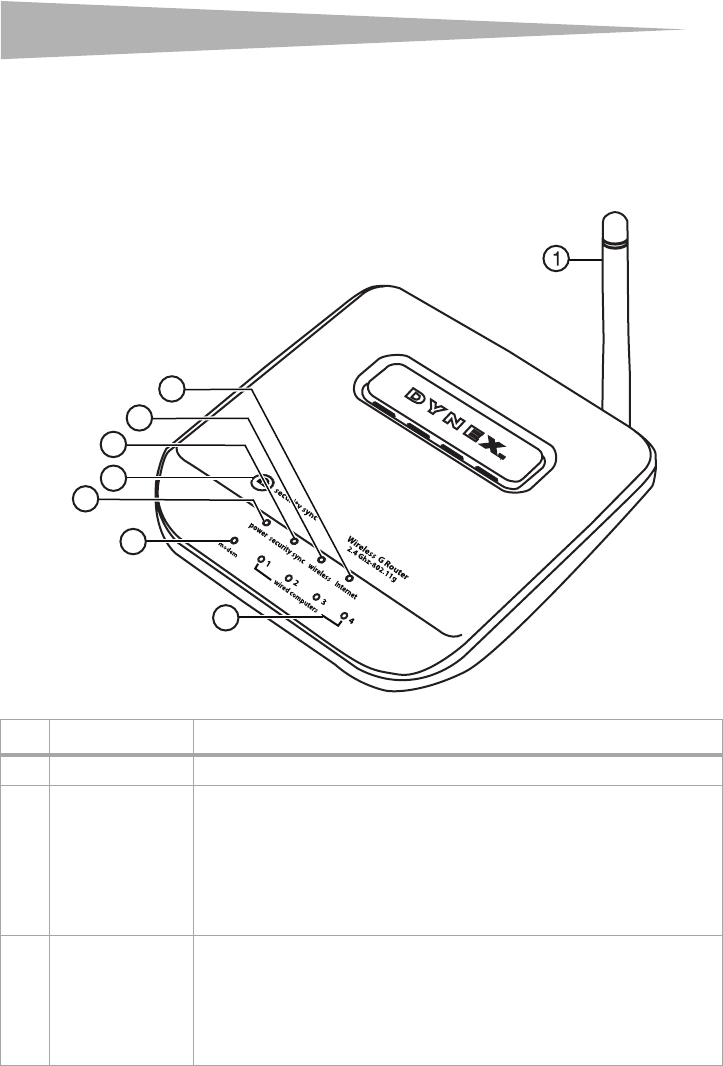
64 Caractéristiques du produit
Composants
Le routeur a été conçu pour être placé sur un bureau. Tous les câbles sont fixés à l’arrière afin
de faciliter l’organisation et l’utilisation. Les témoins lumineux visibles à l’avant du routeur
fournissent des informations sur l’activité et l’état du réseau.
Panneau avant
# Composant Description
1 Antenne Permet au routeur de communiquer avec un client sans fil (carte ou adaptateur USB).
2DEL Alimentation/
Marche Lors de la mise sous tension ou d'un redémarrage du routeur, il s'écoule un petit laps
de temps nécessaire à son amorçage. Pendant ce temps, la DEL Alimentation/Marche
clignote. Lorsque le routeur est entièrement amorcé, la DEL Alimentation/Marche
s’allume en permanence pour indiquer que le routeur est prêt à être utilisé.
Éteint – Le routeur est éteint
Vert clignotant – Le routeur est en cours d'amorçage
Vert continu – Le routeur est prêt
3Touche de
synchronisation de
sécurité
Appuyer sur cette touche pendant trois secondes, puis initier la procédure de
synchronisation de sécurité (WPS) sur le périphérique client dans les deux minutes
suivantes. Le client échangera automatiquement les informations de sécurité et sera
ajouté au réseau sans fil. Le fait d'appuyer sur la touche de synchronisation de
sécurité activera automatiquement WPS. Voir « Utilisation de la synchronisation de
sécurité (WPS) » à la page 87.
2
7
4
5
8
6
3

Caractéristiques du produit 65
4DEL de
synchronisation de
sécurité
S’allume pour indiquer que WPS a été activé.
Vert clignotant – Le routeur cherche un client WPS pour établir une connexion.
Vert continu – La connexion sécurisée a été établie avec le client.
5 DEL du réseau sans fil Éteint – Le réseau sans fil est éteint
Vert continu – Le réseau sans fil est prêt
Vert clignotant – Activité du réseau
6 DEL Internet Cette DEL unique indique lorsque le routeur est connecté à l’Internet. Lorsque le
témoin est éteint, le routeur n’est pas connecté à l’Internet. Lorsque le témoin
clignote, le routeur essaye de se connecter à l’Internet. Lorsque le témoin reste
allumé en vert, sans clignoter, le routeur est connecté à l’Internet. Lors de l'utilisation
de la fonction « Disconnect after x minutes » (Déconnecter après x minutes), cette
DEL devient très utile pour surveiller l'état de la connexion du routeur.
Éteint – Le routeur n’est pas connecté à l’Internet
Vert clignotant – Le routeur essaye de se connecter à l’Internet
Vert continu – Le routeur est connecté à l’Internet
7 DEL d'état du modem Cette DEL s'allume en vert pour indiquer que le modem est correctement connecté au
routeur. Elle clignote rapidement lorsque des informations transitent par le port entre
le routeur et le modem.
Éteint – Aucune liaison WAN
Vert continu – Bonne liaison WAN
Vert clignotant – Activité WAN
8 DEL d'état des
ordinateurs câblés Ces DEL portent les numéros 1 à 4 et correspondent aux numéros des ports à l’arrière
du routeur. Lorsqu’un ordinateur est correctement connecté à l’un des ports pour
ordinateurs câblés à l’arrière du routeur, la DEL correspondante s'allume : vert signifie
qu’un périphérique 10Base-T est connecté, ORANGE signifie qu’un périphérique
100Base-T est connecté. Lorsque des informations sont envoyées par le port, la DEL
clignote rapidement.
Éteint – Le réseau sans fil est éteint
Vert continu – Un périphérique 10base-T est connecté
Orange continu – Un périphérique 100base-T est connecté
Clignotement – Activité du port
# Composant Description
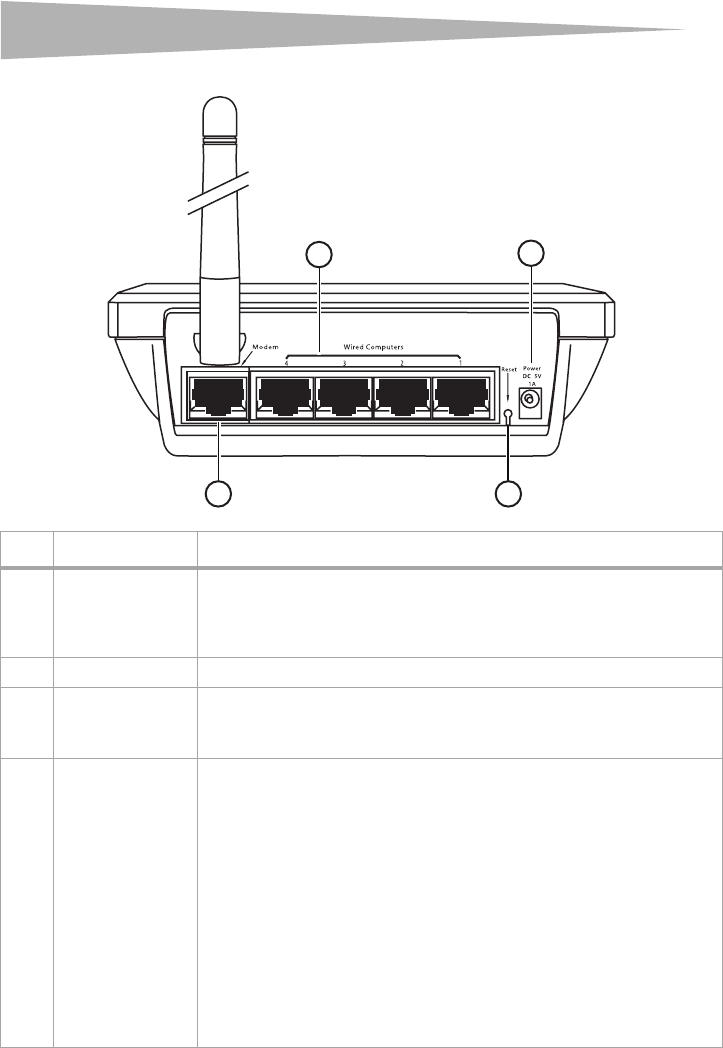
66 Caractéristiques du produit
Panneau arrière
# Composant Description
1 Ports pour
ordinateurs câblés -
Bleus
Connecter les ordinateurs câblés (et non pas sans fil) sur ces ports. Ces ports sont des
ports 10/100 RJ45 à négociation automatique et à liaison ascendante automatique
pour un câble Ethernet UTP standard de catégorie 5 ou 6. Ces ports portent les
numéros 1 à 4 et correspondent aux DEL numérotées à l’avant du routeur.
2 Prise d’alimentation Le bloc d’alimentation 5 V CC fourni se branche sur cette prise.
3 Port modem - Vert Ce port permet de brancher un modem câble ou DSL. Utiliser le câble fourni avec le
modem pour connecter le modem à ce port. L’utilisation d’un autre câble que celui
fourni avec le modem câble risque de ne pas fonctionner correctement.
4Touche de
réinitialisation La touche de réinitialisation (Reset) s’utilise dans les rares cas où le routeur peut
fonctionner de façon incorrecte. La réinitialisation du routeur rétablit son
fonctionnement normal tout en conservant les paramètres programmés. Il est
également possible de rétablir les paramètres d’usine en utilisant la touche de
réinitialisation. Utiliser l’option de rétablissement en cas d'oubli du mot de passe.
Réinitialisation du routeur – Appuyer sur la touche de réinitialisation (Reset),
puis la relâcher. Les témoins du routeur clignotent momentanément. Le témoin
Alimentation/Marche clignote. Lorsque le témoin Alimentation/Marche reste allumé
sans clignoter, la réinitialisation est terminée.
Rétablissement des paramètres par défaut du fabricant – Appuyer sur la touche de
réinitialisation (Reset) pendant au moins 10 secondes, puis la relâcher. Les témoins
du routeur clignotent momentanément. Le témoin Alimentation/Marche clignote.
Lorsque le témoin Alimentation/Marche reste allumé sans clignoter, le
rétablissement est terminé.
1
3
2
4

Installation du routeur sans fil 67
Installation du routeur sans fil
Configuration requise pour le modem
Le modem câble ou DSL doit être équipé d’un port Ethernet RJ45. De nombreux modems
possèdent à la fois un port Ethernet RJ45 et une connexion USB. Si le modem en service est à
la fois Ethernet et USB, et que la connexion USB est celle qui est utilisée à ce moment-là, un
message demandera d’utiliser le port Ethernet RJ45 pendant la procédure d’installation. Si le
modem est équipé uniquement d’un port USB, il faudra demander un autre type de modem
au FSI ou, dans certains cas, acheter un modem équipé d’un port Ethernet RJ45.
Important : Toujours installer d’abord le routeur! En cas d’installation de plusieurs
dispositifs réseau pour la première fois, il est important que le routeur soit connecté et
fonctionne avant d'essayer d’installer d'autres composants réseau, tels que les cartes pour
ordinateurs portatifs ou pour ordinateurs de bureau.
Assistant Configuration
Dynex propose un Assistant Configuration pour rendre l’installation du routeur simple et
facile. Grâce à lui, le routeur peut être prêt à fonctionner en quelques minutes. L’Assistant
Configuration requiert que l’ordinateur sous Windows 2000 ou XP soit connecté directement
au modem câble ou DSL et que la connexion à l’Internet soit active et qu’elle fonctionne au
moment de l’installation. Si ce n'est pas le cas, il faudra utiliser la section « Autre méthode de
configuration » de ce Guide de l'utilisateur pour configurer le routeur. En outre, si le système
d’exploitation utilisé n'est pas Windows 2000 ou XP, il faudra configurer le routeur en
utilisant également la section « Autre méthode de configuration » de ce Guide de
l'utilisateur.
Connexion du matériel
Pour connecter le matériel :
1Débrancher le cordon d'alimentation du modem. Placer le routeur à côté du modem et
relever l'antenne du routeur.
2Repérer le câble réseau qui permet de connecter le modem et l'ordinateur. Débrancher
ce câble du modem et le connecter à l'un des ports de couleur bleue à l'arrière du
routeur.
3Prendre le nouveau câble réseau (inclus dans la boîte avec le routeur) et le connecter
au port de couleur verte à l'arrière du routeur. Connecter l'autre extrémité au modem,
dans le port qui est maintenant libre.
4Brancher le cordon d'alimentation du modem. Attendre 60 secondes pour permettre
au modem de s'initialiser. Brancher l'alimentation du routeur sur le port de couleur
noire situé à l'arrière du routeur. Brancher l’autre extrémité sur une prise secteur.
5Attendre 20 secondes pour permettre au routeur de s'initialiser. Vérifier que le témoin
Modem et l'un des témoins Wired Computers (Ordinateurs connectés) sont allumés
en vert sur la face avant du routeur. Si ce n'est pas le cas, vérifier de nouveau les
connexions.
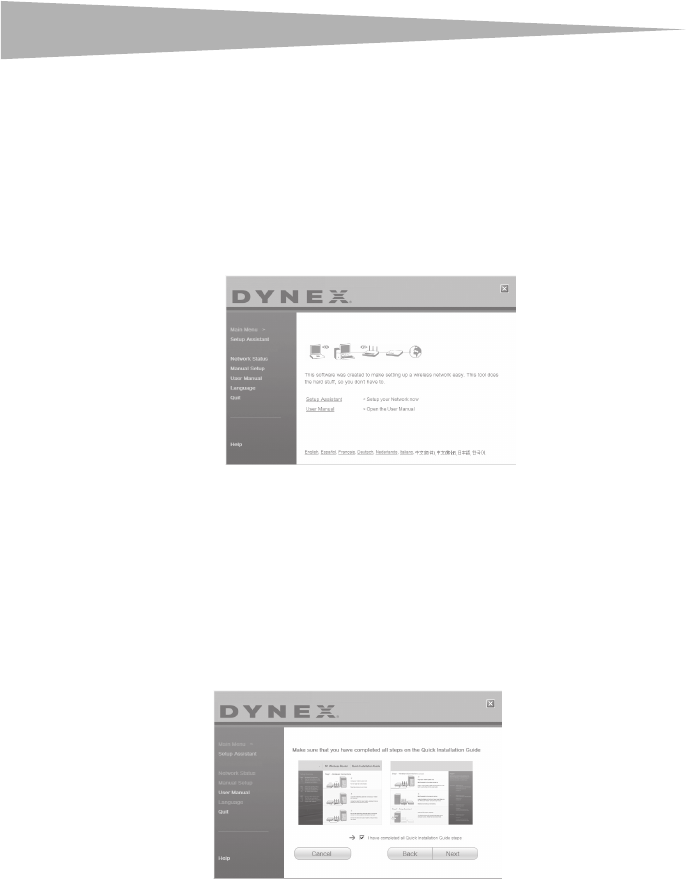
68 Installation du routeur sans fil
Exécution de l'Assistant Configuration
Pour exécuter l'Assistant Configuration :
1Fermer tous les programmes en cours d'exécution sur l'ordinateur.
2Désactiver tout pare-feu ou logiciel de partage de connexion Internet sur l'ordinateur.
3Insérer le CD d'installation dans l'ordinateur. L'Assistant Configuration (Setup
Assistant) s'affichera automatiquement sur l'écran de l'ordinateur en moins de
15 secondes. Double-cliquer sur l'Assistant Configuration pour l'exécuter, puis suivre
les instructions à l'écran.
Important : Exécuter l'Assistant Configuration à partir de l'ordinateur qui est directement
connecté au routeur.
Remarque : Pour les utilisateurs de Windows : Si l'Assistant Configuration ne démarre pas
automatiquement, sélectionner le lecteur CD/DVD à partir de My Computer (Poste de
travail) et double-cliquer sur le fichier appelé Setup Assistant (Assistant Configuration)
pour démarrer l'Assistant Configuration.
4Lorsque l'écran de confirmation s'affiche, confirmer que toutes les étapes du guide
d'installation rapide ont été effectuées en cochant la case à droite de la flèche, puis
cliquer sur Next (Suivant) pour continuer.
DYN EX
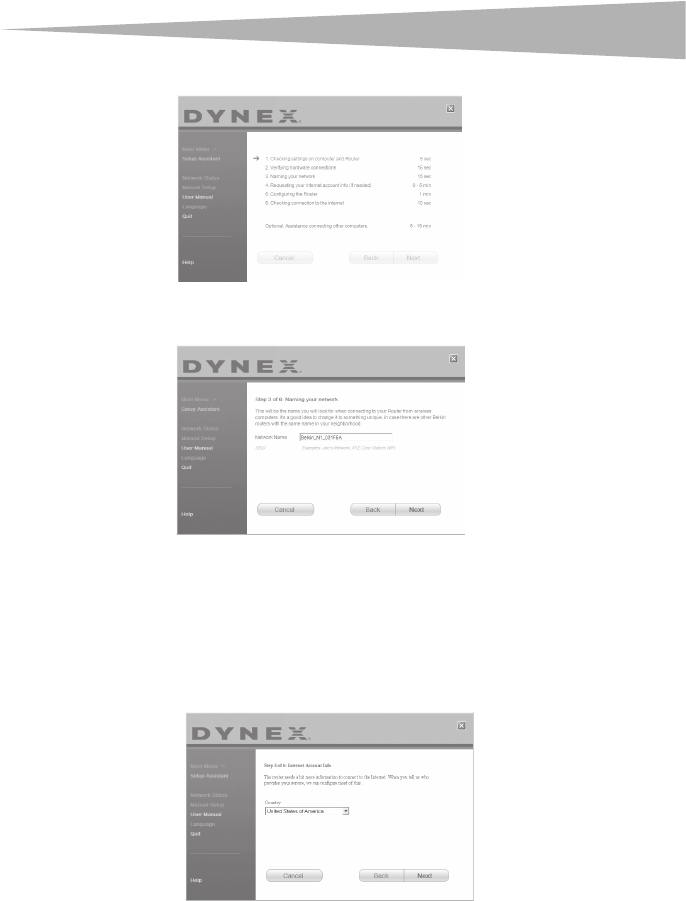
Installation du routeur sans fil 69
L'Assistant Configuration indiquera la fin de chaque étape de la configuration.
Lorsqu'il convient de donner un nom au réseau, l'Assistant Configuration ouvre l'écran
Naming your network (Donner un nom au réseau).
Nom du réseau sans fil ou SSID (Service Set Identifier) par défaut. Il s'agit du nom du
réseau sans fil auquel les ordinateurs ou périphériques munis d'un adaptateur réseau
sans fil se connecteront.
5Il est possible soit d'accepter le nom par défaut, soit de le remplacer par un nom
personnalisé. En cas de modification du nom, le noter par écrit pour référence
ultérieure. Cliquer sur Next (Suivant) pour continuer. L’écran Internet Account Info
(Informations relatives au compte Internet) s’affiche.
6Si le compte Internet exige un nom d'utilisateur et un mot de passe, un écran similaire
à l'illustration ci-dessus s'affichera. Sélectionner un pays ou un FSI dans les listes.
L'Assistant Configuration configure alors le routeur en lui envoyant des données et en
le redémarrant. Attendre les instructions à l’écran.
Remarque : Ne déconnecter aucun câble et ne pas mettre le routeur hors tension pendant
que celui-ci redémarre. Cela rendrait le routeur inutilisable.
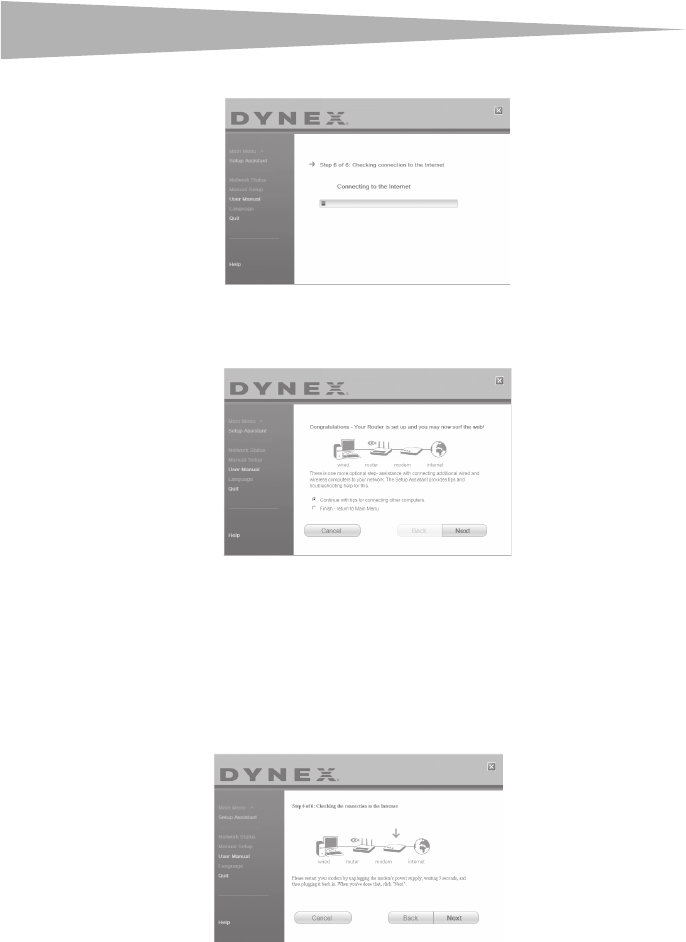
70 Installation du routeur sans fil
Une fois le routeur configuré, l'Assistant Configuration vérifie la connexion à l’Internet.
Ceci termine l'installation du routeur. L'écran Congratulations (Félicitations) s'affiche
lorsque le routeur peut se connecter à l’Internet. Il est alors possible de commencer à
surfer en ouvrant un navigateur Web et en se rendant sur n'importe quel site Web.
7L'Assistant Configuration peut être utilisé pour configurer les autres ordinateurs câblés
et sans fil, afin de les connecter à l’Internet, en cliquant sur Next (Suivant). Pour
ajouter ultérieurement des ordinateurs au routeur, sélectionner Exit the Assistant
(Quitter l'assistant), puis cliquer sur Next (Suivant).
Pour identifier et résoudre les problèmes de configuration :
1Si l'Assistant Configuration ne parvient pas à établir une connexion Internet, l'écran
suivant s'affichera. Suivre les instructions à l'écran pour procéder à l'identification et à
la résolution des problèmes.